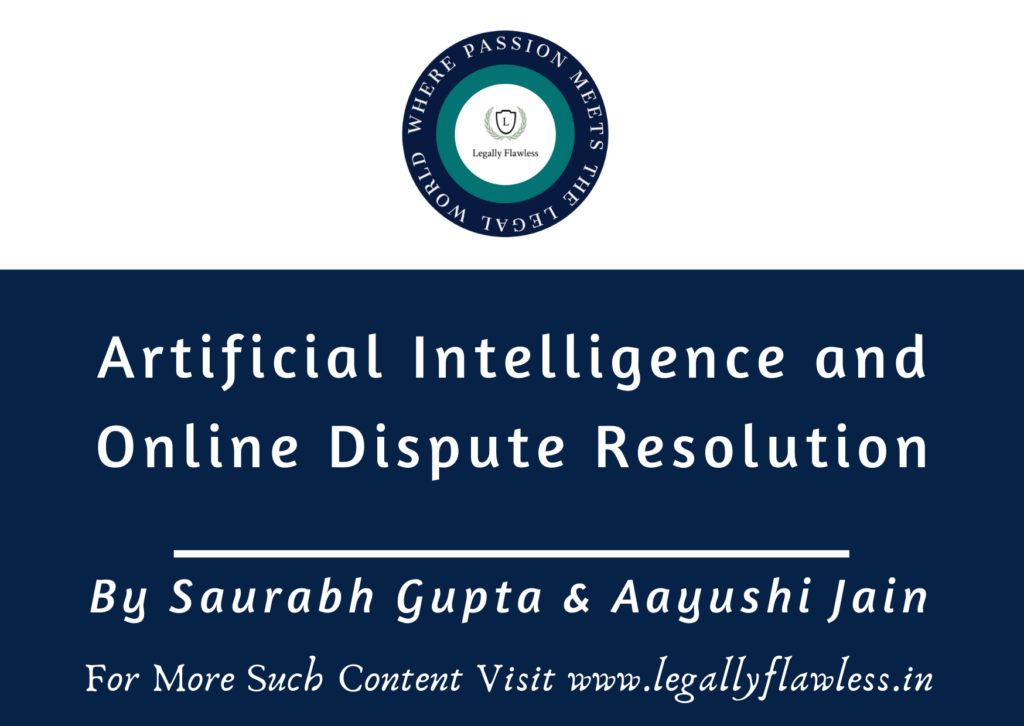
Table of Contents
Introduction
Law is essentially a subject of resolving conflicts. The primary conflict resolution method is still judicial litigation. Courts are getting slower and more antiquated, though, because to the volume and nature of the new disputes—which primarily result from electronic contracting.
The proliferation of Online Dispute Resolution (ODR) is both tangible and theoretical. Practically, systems have been developed to manage low-complexity conflicts, while many commentators suggest that this technology marks the dawn of a new era for dispute resolution and the legal system. Furthermore, artificial intelligence (AI) has recently become a major component of ODR. AI has made its mark in a variety of dispute resolution capacities, with the potential to act as either an aid or a replacement for traditional resolution methods. There are, however, substantial risks associated with relying on AI-based ODR systems; they may overlook elements such as emotional responses or nuances in negotiations that would otherwise be addressed with conventional techniques.
This blog critically investigates the problems with the interface between people and machines and evaluates how they could affect ODR. Introduction to AI and Dispute Resolution The importance of AI in dispute resolution, the current function of AI in ODR, and how AI might impede access to justice.
Defining Online dispute resolution
ODR may be defined as the use of information and communication technologies to assist parties in avoiding conflict and resolving it. ODR broadly refers to a simpler, quicker, and more effective way to pursue ADR.
The scope of this study does not provide a thorough examination of the various ADR definitions. However, it is often seen as alternatives to established legal systems or courtroom litigation for resolving disputes. However, describing ODR as merely “ADR plus online tools” would be too broad given the pervasiveness of networked communication.
Demystifying ‘Consent’ in Marital Rape in India
Current role of AI in ODR
It’s vital to analyse the history and current interaction between AI and ODR before thinking about the role of AI in ODR in the future. In the past, AI has contributed to the administration of justice, the protection of human rights, and the advancement of moral principles. For instance, by settling disagreements, legal work may be made easier and more effective. Helping individuals to comprehend the method through which people create and support legal arguments is one way to do this. Information processing, reasoning, and decision-making are all steps in the process of creating and enforcing law. Similar to how humans retrieve information, AI also uses data mining, machine learning, natural language processing, knowledge representation, and reasoning.
Importance AI in Dispute Resolution
Supportive AI systems
The most common technology in the modern ODR context are supportive AI systems. This phenomena is somewhat unsurprising because it is much simpler to build a tool for a human to use than to completely replace the human. According to the type of support they offer, supportive AI systems can be further divided into different categories.
Decision support systems.
AI is proving to be a very promising tool in the field of Online Dispute Resolution (ODR). Since the early 90s, it has been the area which has seen the most development. This isn’t surprising, as AI’s capability of assessing different factors and calculating the optimal outcome or action is an indicator of its success. AI processes have been applied to ODR and such supportive systems should be considered when dealing with it. Generally, they are able to inform both parties on the degree of agreement or disagreement. For instance, with an amicable divorce settlement, the value of objects can be subjectively determined due to underlying emotional factors. This calls for systems like Family Winner which ask each side to prioritize items and use algorithms to determine an optimum distribution. Other systems like SmartSettle assist mediators in finding outcomes agreeable for both parties and these adjust as negotiations progress. There are other AI-based ODR solutions such as Adjusted Winner, AssetDivider, ALIS and GetAid which require human input to work properly. To assess their viability in geopolitics, they have been tested against historical disputes – such as opposed to the Camp David Accords – and have produced similar results. The combination of AI and ODR is proving invaluable for ensuring that both parties’ needs are met now and in the future.
Knowledge support systems
Decision support systems can provide procedural guidance, and AI can be used to access information related to a particular conflict. In considering these systems, creating an ‘intelligent’ search engine would require the ability to comprehend and understand the components of a certain circumstance. This would enable the system to produce relevant info for a given scenario. While this is hard enough in the legal field, it is even harder in other ODR contexts where rules are not codified by law but instead come from past dealings or cases with complex knowledge. Still, these systems can be very beneficial in resolving disputes as they make it easier to uncover necessary information like evidence, precedent-setting cases, etc.
AI and access to justice
The development of AI in ODR is theoretically a process of liberalization, as is the case with the development of many new technologies; it represents the expansion of simpler, less expensive, more widely available, and more effective resolution methods. This claim, however, can be disputed as oversimplifying the potential long-term implications of AI on ODR. In fact, it is possible to argue that the opposite is true—that the application of AI will actually make it more difficult to attain justice. Arguments against this procedure can be divided into two categories. First, there is a case to be made that eliminating conventional third parties will have some advantageous consequences. Second, it is possible to hypothesise that the nature of AI as a technology would result in the development of a two-tiered dispute resolution system. Below, we go into greater information about both points of view.
How AI can inhibit access to justice
It is tempting to view new technologies with optimism, however, it is critical to carefully consider the potential impacts it can have on equality. This will enable informed decisions and protections to be put in place. Therefore, before AI in ODR is accepted in any context, this analysis must be conducted. First of all, it’s essential to establish if everyone has the same level of knowledge and understanding when it comes to using AI. Interfacing between humans and AI can be difficult due to translation processes, so for people to take advantage of AI in ODR, they need a certain level of proficiency with modern technology – something which many elderly individuals may not have. If training or education isn’t supplied here, an access gap will likely form. Simply providing the technology alone may not be enough; the UK Government’s push towards a digital world could leave 5 million citizens who have never used the internet behind. Education should come first before implementation can occur in order for everybody to benefit from such services.
Furthermore, once AI is well established within the private sector, a two-tier system could arise with expensive providers having access to more efficient AI systems compared to cheaper ones who do not have such resources. For example, when initial supportive AI services are developed in knowledge support, those who cannot use AI systems may be at a disadvantage due to how quickly those with access can process large volumes of documents – this has been dubbed as “a knife to a gun-fight” scenario. If disputes shift mainly towards using AI-based ODR without other options available this could lead people unable to access justice due to financial barriers.
It should also be noted that inequality within dispute resolution is also seen with litigation and traditional ADR forms; where one party might only be able afford high-street lawyers compared to those hiring Queen’s Counsel or Magic Circle lawyers for example – however if AI struggles without overcoming obstacles that existing solutions do then its true value won’t be realized effectively either way. Currently those on moderate incomes can pay for representation relative to the complexity of their case which won’t change significantly because of AI implementation.
Moving forwards there may also become an issue when it comes pro bono advice since precursor forms of AI are mainly used for less complicated cases which tend involve junior lawyers providing assistance at minimal cost – if so then this assistance may disappear since its role will have been taken by computer programs instead – leaving only small satellite firms still offering such services while junior lawyers move elsewhere away from major firms capable of paying for such technology instead.
It can be argued that the emergence of AI could lead to a market dumping phenomenon, wherein AI would replace pro bono or low-cost lawyers, and potentially reduce access to justice. Whether this is a significant issue will depend on how accessible AI is to those with limited financial resources. If developers provide free/low-cost access through charitable donations or government regulations, then access to justice won’t be affected. However, if managed poorly, this could have negative consequences for the disempowered. Even without such a phenomenon occurring, Lord Justice Briggs’ call for an online court system suggests that emphasis may be placed on AI-led ODR for lower value cases, meaning the progression of cases might depend more on financial value rather than justice. This could make traditional courts the preserve of the wealthy and leave those with less money having to rely on AI services instead.
Afraid of Layoffs? Analyzing its legality and impact
Conclusion
This paper has assessed the role AI plays in ODR and how it could develop to improve the resolution of legal disputes. Technology advancements and greater transnational transactions between wealthy and less affluent countries will increase the demand for AI systems in dispute resolution. AI has long been a part of justice, protecting rights, and promoting values. It is not merely a tool to help with resolution, but a declaration or forum itself. However, despite optimistic predictions, AI in ODR has seen slower development than expected. Still, it’s likely that these systems can reduce bottlenecks in judicial systems by eliminating red tape and litigation—though this may lead to two-tiered dispute resolution. That said, blindly relying on AI could be harmful if we don’t review it regularly; leaving it to its own parameters may cause it to deviate from its intended purpose. Additionally, care must be taken that AI-based ODR does not worsen access to justice for those who already have little means of obtaining it—compliance with accessibility standards is essential for success with this type of forum.
This article is authored by Saurabh Gupta and Aayushi Jain, 4th-year students at Institute of Law, Nirma University


